Contemporary Accounting Theory: Framework and Reporting Analysis
VerifiedAdded on 2023/04/03
|20
|3796
|249
Report
AI Summary
This report delves into the conceptual framework of financial reporting, examining its historical development in the USA, UK, Australia, and globally under the IASB. It addresses the Australian accounting profession's concerns regarding the application of the framework and critically discusses academic concerns about its quality, including potential benefits and limitations. The report also investigates sustainability reporting guidelines as per GRI and IIRC, comparing the strengths and limitations of conventional accounting. Furthermore, it analyzes the integrated reports of Iress Ltd (Australia) and Naspers Ltd (South Africa), assessing their adherence to integrated reporting components and principles. The report concludes with a comprehensive overview of the conceptual framework and its impact on contemporary accounting practices.
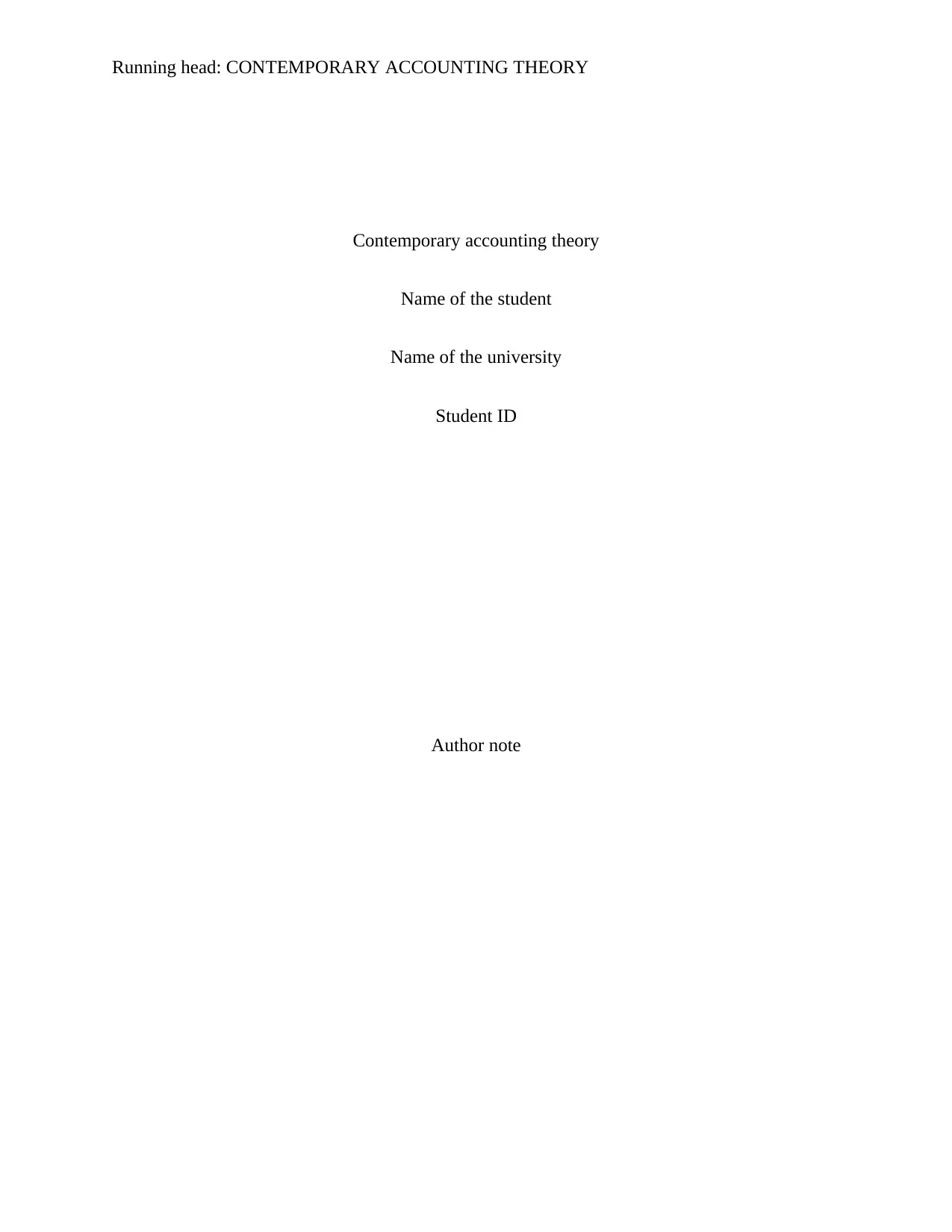
Running head: CONTEMPORARY ACCOUNTING THEORY
Contemporary accounting theory
Name of the student
Name of the university
Student ID
Author note
Contemporary accounting theory
Name of the student
Name of the university
Student ID
Author note
Paraphrase This Document
Need a fresh take? Get an instant paraphrase of this document with our AI Paraphraser
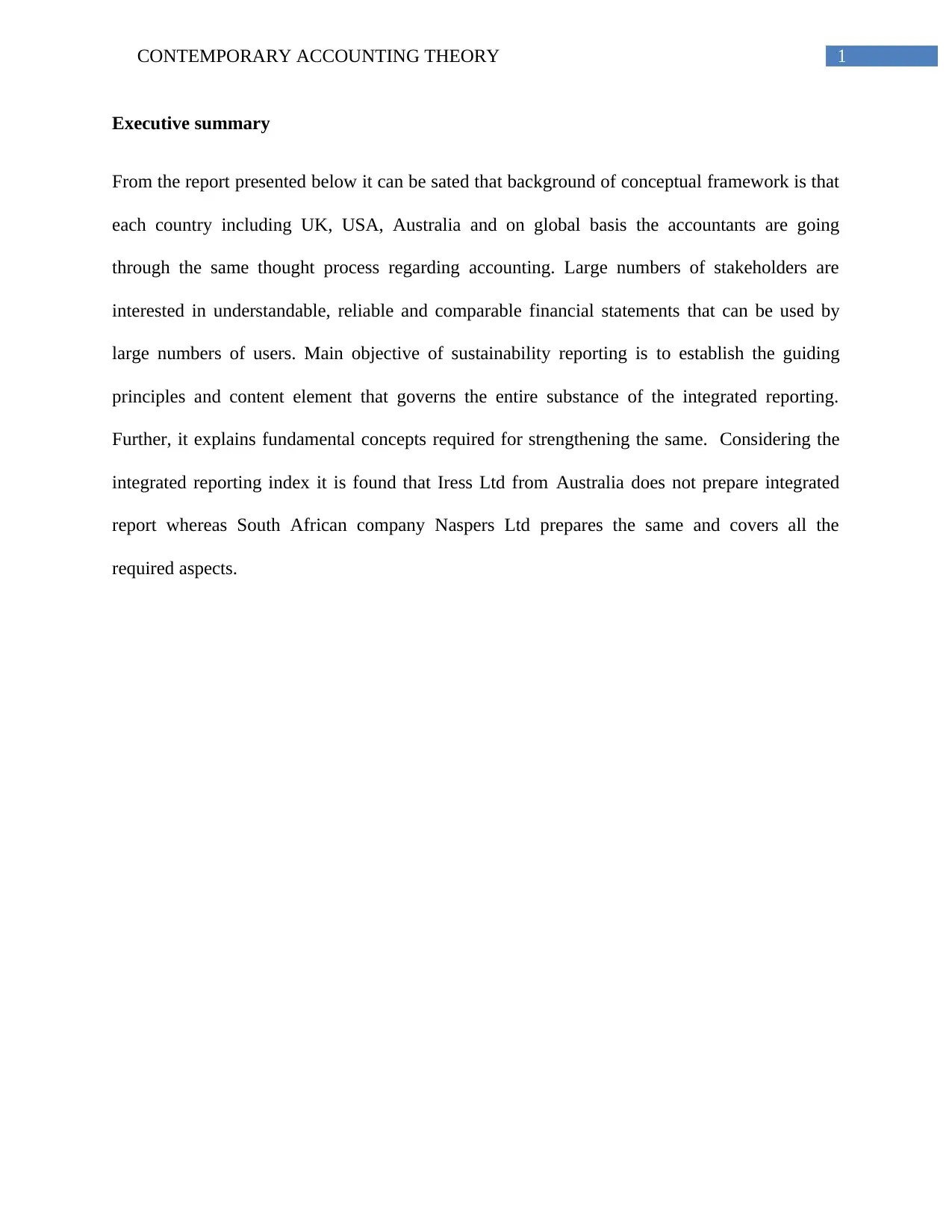
1CONTEMPORARY ACCOUNTING THEORY
Executive summary
From the report presented below it can be sated that background of conceptual framework is that
each country including UK, USA, Australia and on global basis the accountants are going
through the same thought process regarding accounting. Large numbers of stakeholders are
interested in understandable, reliable and comparable financial statements that can be used by
large numbers of users. Main objective of sustainability reporting is to establish the guiding
principles and content element that governs the entire substance of the integrated reporting.
Further, it explains fundamental concepts required for strengthening the same. Considering the
integrated reporting index it is found that Iress Ltd from Australia does not prepare integrated
report whereas South African company Naspers Ltd prepares the same and covers all the
required aspects.
Executive summary
From the report presented below it can be sated that background of conceptual framework is that
each country including UK, USA, Australia and on global basis the accountants are going
through the same thought process regarding accounting. Large numbers of stakeholders are
interested in understandable, reliable and comparable financial statements that can be used by
large numbers of users. Main objective of sustainability reporting is to establish the guiding
principles and content element that governs the entire substance of the integrated reporting.
Further, it explains fundamental concepts required for strengthening the same. Considering the
integrated reporting index it is found that Iress Ltd from Australia does not prepare integrated
report whereas South African company Naspers Ltd prepares the same and covers all the
required aspects.
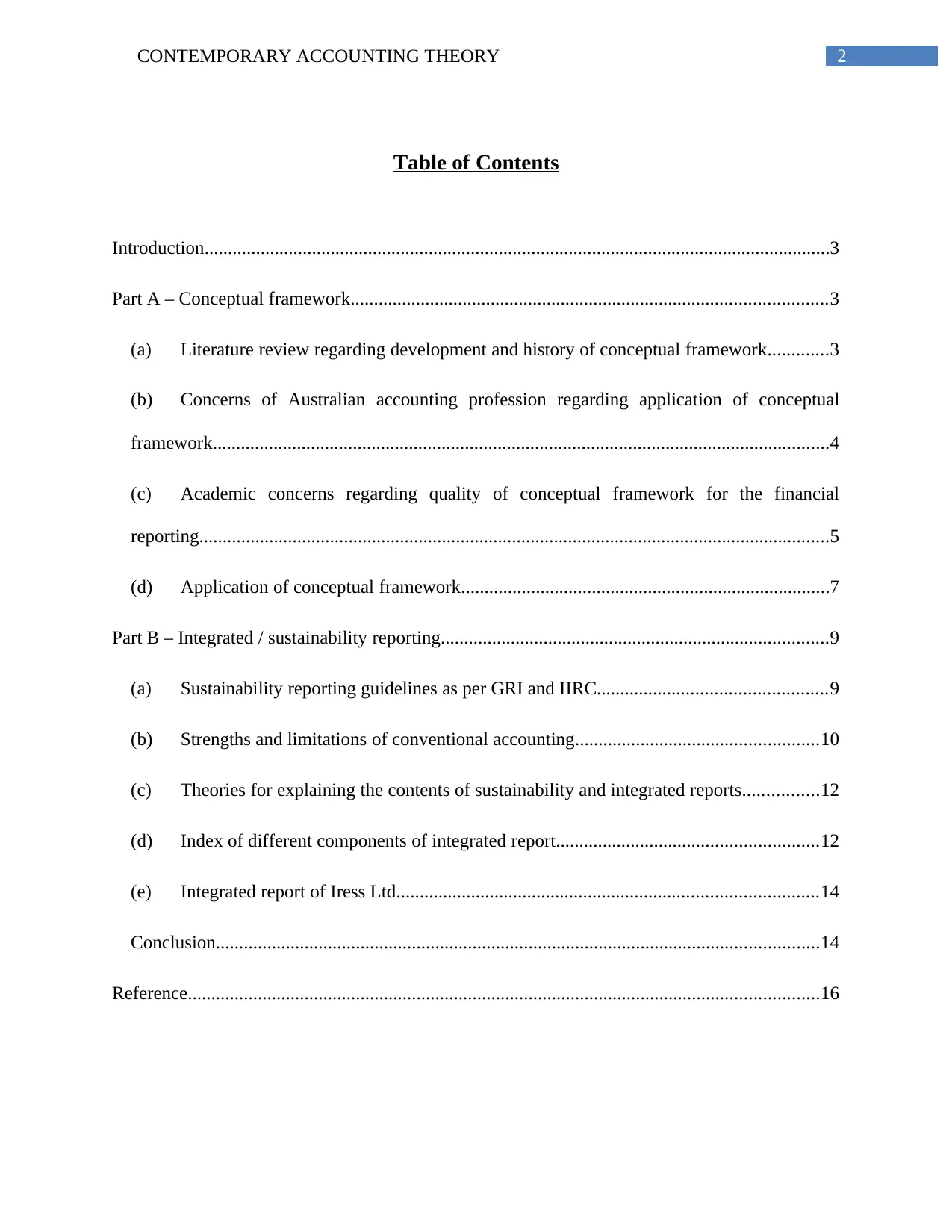
2CONTEMPORARY ACCOUNTING THEORY
Table of Contents
Introduction......................................................................................................................................3
Part A – Conceptual framework......................................................................................................3
(a) Literature review regarding development and history of conceptual framework.............3
(b) Concerns of Australian accounting profession regarding application of conceptual
framework....................................................................................................................................4
(c) Academic concerns regarding quality of conceptual framework for the financial
reporting.......................................................................................................................................5
(d) Application of conceptual framework...............................................................................7
Part B – Integrated / sustainability reporting...................................................................................9
(a) Sustainability reporting guidelines as per GRI and IIRC.................................................9
(b) Strengths and limitations of conventional accounting....................................................10
(c) Theories for explaining the contents of sustainability and integrated reports................12
(d) Index of different components of integrated report........................................................12
(e) Integrated report of Iress Ltd..........................................................................................14
Conclusion.................................................................................................................................14
Reference.......................................................................................................................................16
Table of Contents
Introduction......................................................................................................................................3
Part A – Conceptual framework......................................................................................................3
(a) Literature review regarding development and history of conceptual framework.............3
(b) Concerns of Australian accounting profession regarding application of conceptual
framework....................................................................................................................................4
(c) Academic concerns regarding quality of conceptual framework for the financial
reporting.......................................................................................................................................5
(d) Application of conceptual framework...............................................................................7
Part B – Integrated / sustainability reporting...................................................................................9
(a) Sustainability reporting guidelines as per GRI and IIRC.................................................9
(b) Strengths and limitations of conventional accounting....................................................10
(c) Theories for explaining the contents of sustainability and integrated reports................12
(d) Index of different components of integrated report........................................................12
(e) Integrated report of Iress Ltd..........................................................................................14
Conclusion.................................................................................................................................14
Reference.......................................................................................................................................16
⊘ This is a preview!⊘
Do you want full access?
Subscribe today to unlock all pages.

Trusted by 1+ million students worldwide
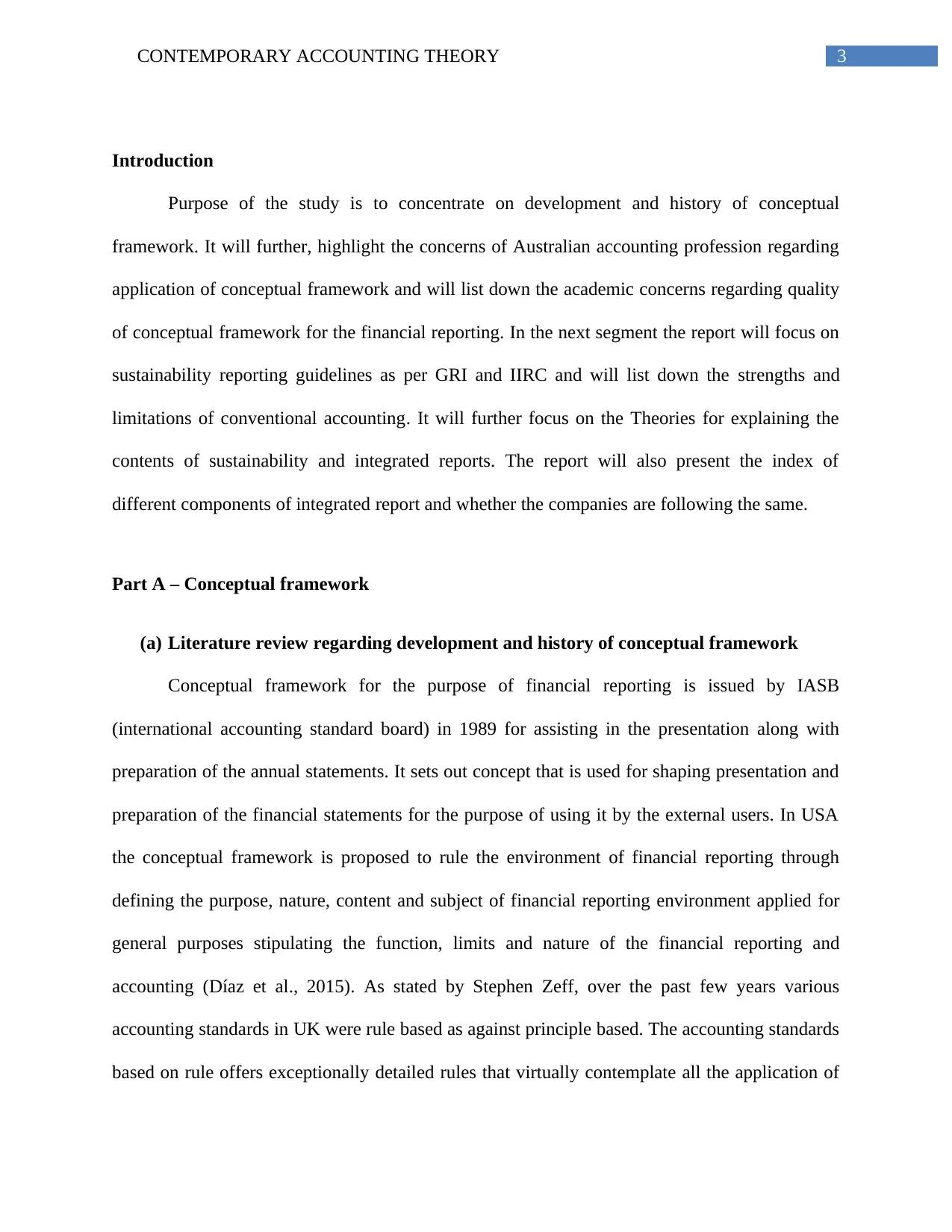
3CONTEMPORARY ACCOUNTING THEORY
Introduction
Purpose of the study is to concentrate on development and history of conceptual
framework. It will further, highlight the concerns of Australian accounting profession regarding
application of conceptual framework and will list down the academic concerns regarding quality
of conceptual framework for the financial reporting. In the next segment the report will focus on
sustainability reporting guidelines as per GRI and IIRC and will list down the strengths and
limitations of conventional accounting. It will further focus on the Theories for explaining the
contents of sustainability and integrated reports. The report will also present the index of
different components of integrated report and whether the companies are following the same.
Part A – Conceptual framework
(a) Literature review regarding development and history of conceptual framework
Conceptual framework for the purpose of financial reporting is issued by IASB
(international accounting standard board) in 1989 for assisting in the presentation along with
preparation of the annual statements. It sets out concept that is used for shaping presentation and
preparation of the financial statements for the purpose of using it by the external users. In USA
the conceptual framework is proposed to rule the environment of financial reporting through
defining the purpose, nature, content and subject of financial reporting environment applied for
general purposes stipulating the function, limits and nature of the financial reporting and
accounting (Díaz et al., 2015). As stated by Stephen Zeff, over the past few years various
accounting standards in UK were rule based as against principle based. The accounting standards
based on rule offers exceptionally detailed rules that virtually contemplate all the application of
Introduction
Purpose of the study is to concentrate on development and history of conceptual
framework. It will further, highlight the concerns of Australian accounting profession regarding
application of conceptual framework and will list down the academic concerns regarding quality
of conceptual framework for the financial reporting. In the next segment the report will focus on
sustainability reporting guidelines as per GRI and IIRC and will list down the strengths and
limitations of conventional accounting. It will further focus on the Theories for explaining the
contents of sustainability and integrated reports. The report will also present the index of
different components of integrated report and whether the companies are following the same.
Part A – Conceptual framework
(a) Literature review regarding development and history of conceptual framework
Conceptual framework for the purpose of financial reporting is issued by IASB
(international accounting standard board) in 1989 for assisting in the presentation along with
preparation of the annual statements. It sets out concept that is used for shaping presentation and
preparation of the financial statements for the purpose of using it by the external users. In USA
the conceptual framework is proposed to rule the environment of financial reporting through
defining the purpose, nature, content and subject of financial reporting environment applied for
general purposes stipulating the function, limits and nature of the financial reporting and
accounting (Díaz et al., 2015). As stated by Stephen Zeff, over the past few years various
accounting standards in UK were rule based as against principle based. The accounting standards
based on rule offers exceptionally detailed rules that virtually contemplate all the application of
Paraphrase This Document
Need a fresh take? Get an instant paraphrase of this document with our AI Paraphraser
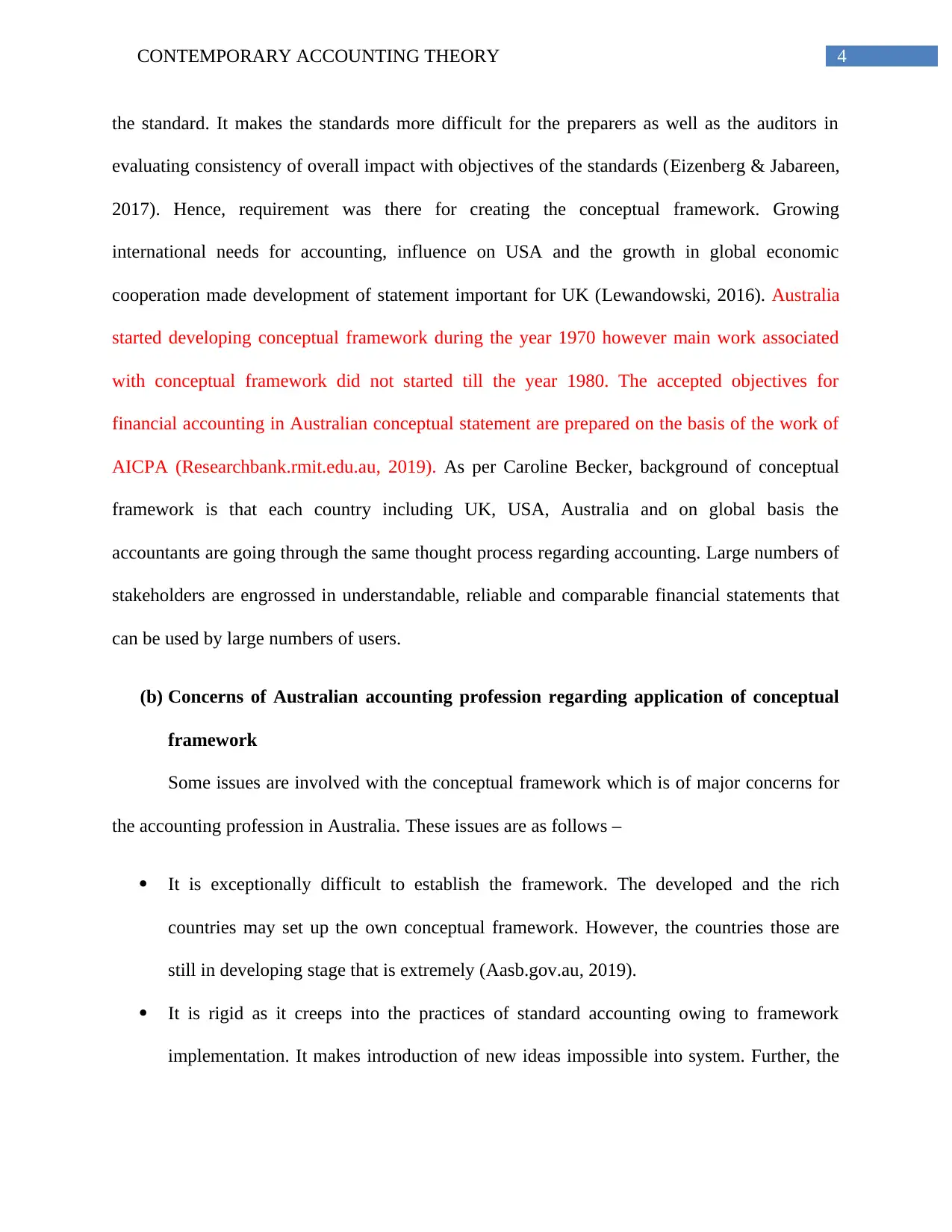
4CONTEMPORARY ACCOUNTING THEORY
the standard. It makes the standards more difficult for the preparers as well as the auditors in
evaluating consistency of overall impact with objectives of the standards (Eizenberg & Jabareen,
2017). Hence, requirement was there for creating the conceptual framework. Growing
international needs for accounting, influence on USA and the growth in global economic
cooperation made development of statement important for UK (Lewandowski, 2016). Australia
started developing conceptual framework during the year 1970 however main work associated
with conceptual framework did not started till the year 1980. The accepted objectives for
financial accounting in Australian conceptual statement are prepared on the basis of the work of
AICPA (Researchbank.rmit.edu.au, 2019). As per Caroline Becker, background of conceptual
framework is that each country including UK, USA, Australia and on global basis the
accountants are going through the same thought process regarding accounting. Large numbers of
stakeholders are engrossed in understandable, reliable and comparable financial statements that
can be used by large numbers of users.
(b) Concerns of Australian accounting profession regarding application of conceptual
framework
Some issues are involved with the conceptual framework which is of major concerns for
the accounting profession in Australia. These issues are as follows –
It is exceptionally difficult to establish the framework. The developed and the rich
countries may set up the own conceptual framework. However, the countries those are
still in developing stage that is extremely (Aasb.gov.au, 2019).
It is rigid as it creeps into the practices of standard accounting owing to framework
implementation. It makes introduction of new ideas impossible into system. Further, the
the standard. It makes the standards more difficult for the preparers as well as the auditors in
evaluating consistency of overall impact with objectives of the standards (Eizenberg & Jabareen,
2017). Hence, requirement was there for creating the conceptual framework. Growing
international needs for accounting, influence on USA and the growth in global economic
cooperation made development of statement important for UK (Lewandowski, 2016). Australia
started developing conceptual framework during the year 1970 however main work associated
with conceptual framework did not started till the year 1980. The accepted objectives for
financial accounting in Australian conceptual statement are prepared on the basis of the work of
AICPA (Researchbank.rmit.edu.au, 2019). As per Caroline Becker, background of conceptual
framework is that each country including UK, USA, Australia and on global basis the
accountants are going through the same thought process regarding accounting. Large numbers of
stakeholders are engrossed in understandable, reliable and comparable financial statements that
can be used by large numbers of users.
(b) Concerns of Australian accounting profession regarding application of conceptual
framework
Some issues are involved with the conceptual framework which is of major concerns for
the accounting profession in Australia. These issues are as follows –
It is exceptionally difficult to establish the framework. The developed and the rich
countries may set up the own conceptual framework. However, the countries those are
still in developing stage that is extremely (Aasb.gov.au, 2019).
It is rigid as it creeps into the practices of standard accounting owing to framework
implementation. It makes introduction of new ideas impossible into system. Further, the
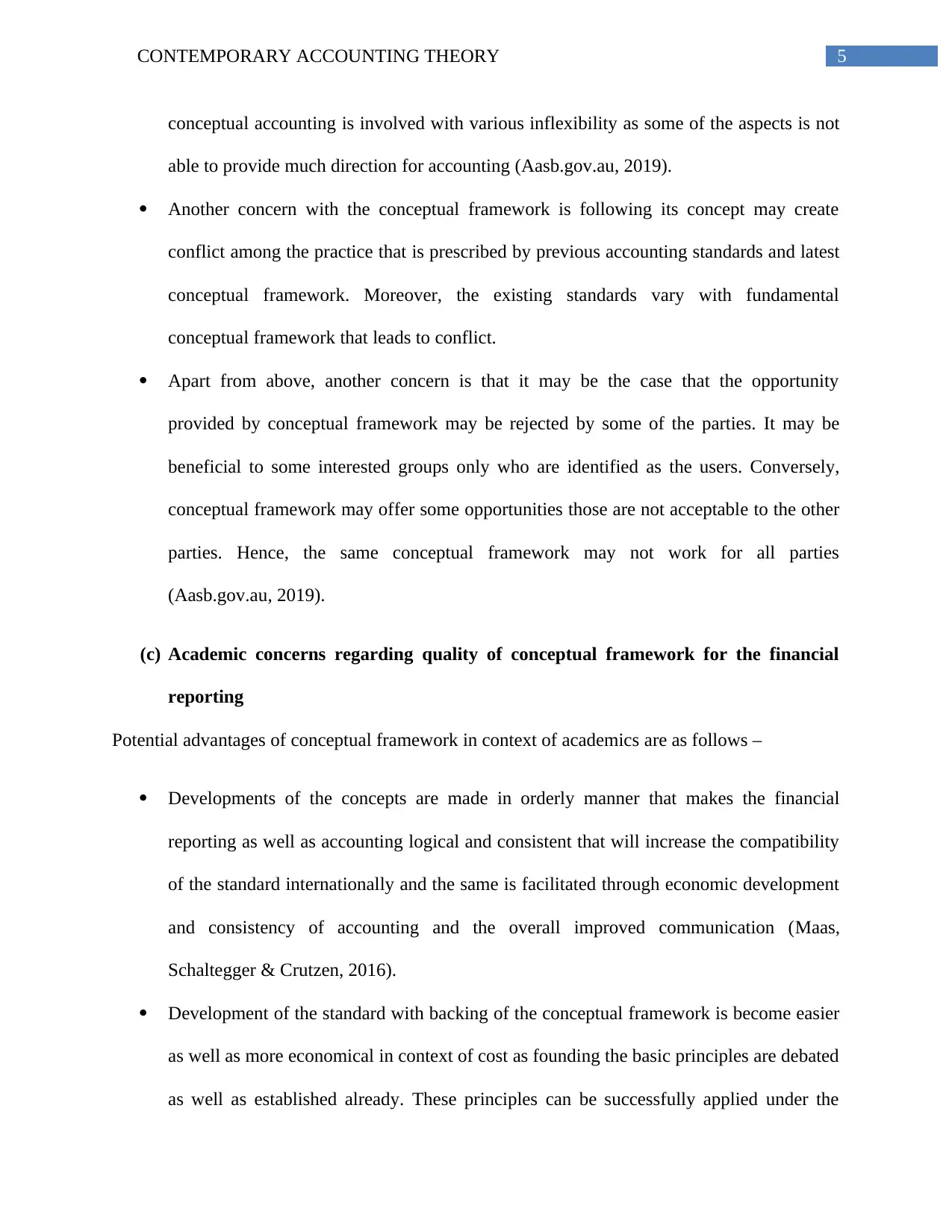
5CONTEMPORARY ACCOUNTING THEORY
conceptual accounting is involved with various inflexibility as some of the aspects is not
able to provide much direction for accounting (Aasb.gov.au, 2019).
Another concern with the conceptual framework is following its concept may create
conflict among the practice that is prescribed by previous accounting standards and latest
conceptual framework. Moreover, the existing standards vary with fundamental
conceptual framework that leads to conflict.
Apart from above, another concern is that it may be the case that the opportunity
provided by conceptual framework may be rejected by some of the parties. It may be
beneficial to some interested groups only who are identified as the users. Conversely,
conceptual framework may offer some opportunities those are not acceptable to the other
parties. Hence, the same conceptual framework may not work for all parties
(Aasb.gov.au, 2019).
(c) Academic concerns regarding quality of conceptual framework for the financial
reporting
Potential advantages of conceptual framework in context of academics are as follows –
Developments of the concepts are made in orderly manner that makes the financial
reporting as well as accounting logical and consistent that will increase the compatibility
of the standard internationally and the same is facilitated through economic development
and consistency of accounting and the overall improved communication (Maas,
Schaltegger & Crutzen, 2016).
Development of the standard with backing of the conceptual framework is become easier
as well as more economical in context of cost as founding the basic principles are debated
as well as established already. These principles can be successfully applied under the
conceptual accounting is involved with various inflexibility as some of the aspects is not
able to provide much direction for accounting (Aasb.gov.au, 2019).
Another concern with the conceptual framework is following its concept may create
conflict among the practice that is prescribed by previous accounting standards and latest
conceptual framework. Moreover, the existing standards vary with fundamental
conceptual framework that leads to conflict.
Apart from above, another concern is that it may be the case that the opportunity
provided by conceptual framework may be rejected by some of the parties. It may be
beneficial to some interested groups only who are identified as the users. Conversely,
conceptual framework may offer some opportunities those are not acceptable to the other
parties. Hence, the same conceptual framework may not work for all parties
(Aasb.gov.au, 2019).
(c) Academic concerns regarding quality of conceptual framework for the financial
reporting
Potential advantages of conceptual framework in context of academics are as follows –
Developments of the concepts are made in orderly manner that makes the financial
reporting as well as accounting logical and consistent that will increase the compatibility
of the standard internationally and the same is facilitated through economic development
and consistency of accounting and the overall improved communication (Maas,
Schaltegger & Crutzen, 2016).
Development of the standard with backing of the conceptual framework is become easier
as well as more economical in context of cost as founding the basic principles are debated
as well as established already. These principles can be successfully applied under the
⊘ This is a preview!⊘
Do you want full access?
Subscribe today to unlock all pages.

Trusted by 1+ million students worldwide
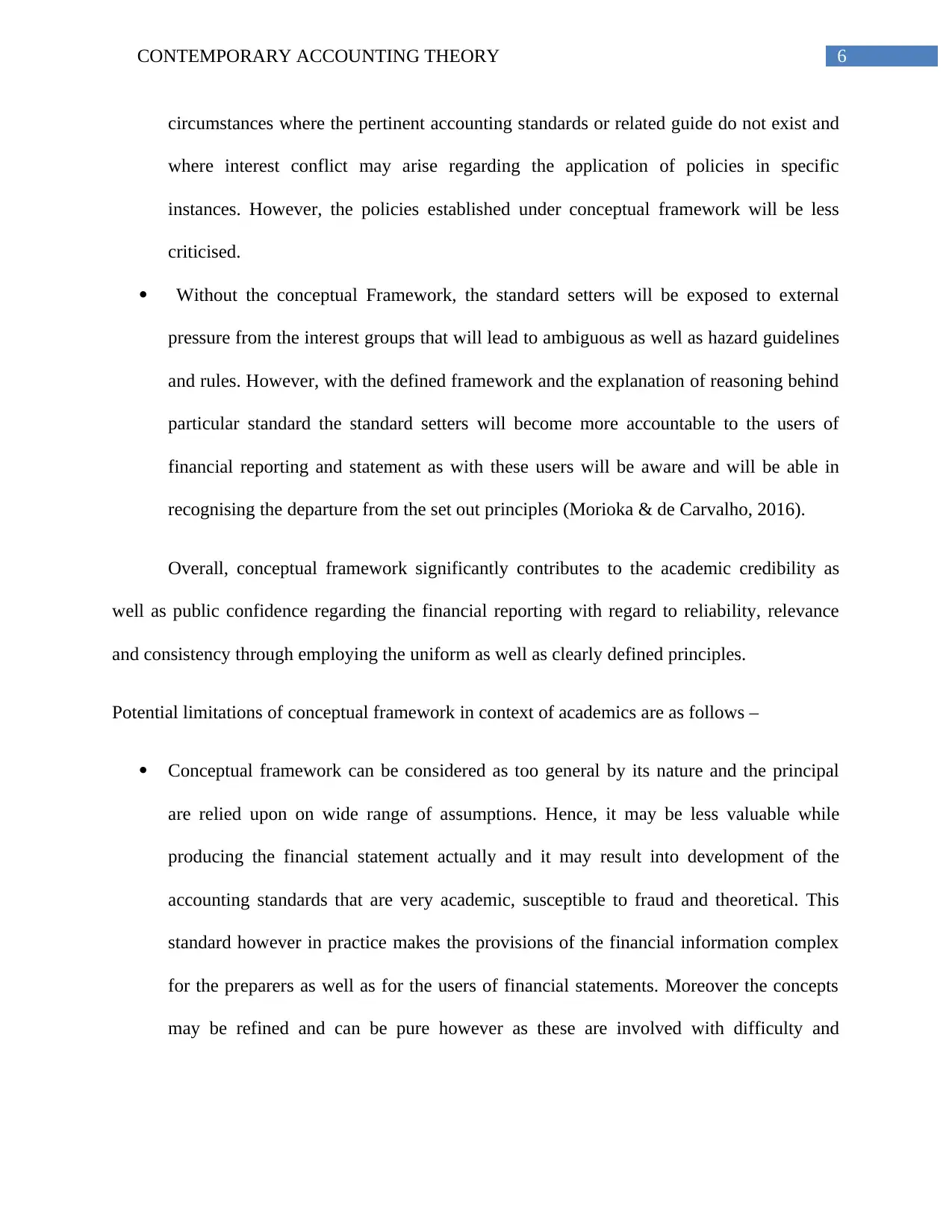
6CONTEMPORARY ACCOUNTING THEORY
circumstances where the pertinent accounting standards or related guide do not exist and
where interest conflict may arise regarding the application of policies in specific
instances. However, the policies established under conceptual framework will be less
criticised.
Without the conceptual Framework, the standard setters will be exposed to external
pressure from the interest groups that will lead to ambiguous as well as hazard guidelines
and rules. However, with the defined framework and the explanation of reasoning behind
particular standard the standard setters will become more accountable to the users of
financial reporting and statement as with these users will be aware and will be able in
recognising the departure from the set out principles (Morioka & de Carvalho, 2016).
Overall, conceptual framework significantly contributes to the academic credibility as
well as public confidence regarding the financial reporting with regard to reliability, relevance
and consistency through employing the uniform as well as clearly defined principles.
Potential limitations of conceptual framework in context of academics are as follows –
Conceptual framework can be considered as too general by its nature and the principal
are relied upon on wide range of assumptions. Hence, it may be less valuable while
producing the financial statement actually and it may result into development of the
accounting standards that are very academic, susceptible to fraud and theoretical. This
standard however in practice makes the provisions of the financial information complex
for the preparers as well as for the users of financial statements. Moreover the concepts
may be refined and can be pure however as these are involved with difficulty and
circumstances where the pertinent accounting standards or related guide do not exist and
where interest conflict may arise regarding the application of policies in specific
instances. However, the policies established under conceptual framework will be less
criticised.
Without the conceptual Framework, the standard setters will be exposed to external
pressure from the interest groups that will lead to ambiguous as well as hazard guidelines
and rules. However, with the defined framework and the explanation of reasoning behind
particular standard the standard setters will become more accountable to the users of
financial reporting and statement as with these users will be aware and will be able in
recognising the departure from the set out principles (Morioka & de Carvalho, 2016).
Overall, conceptual framework significantly contributes to the academic credibility as
well as public confidence regarding the financial reporting with regard to reliability, relevance
and consistency through employing the uniform as well as clearly defined principles.
Potential limitations of conceptual framework in context of academics are as follows –
Conceptual framework can be considered as too general by its nature and the principal
are relied upon on wide range of assumptions. Hence, it may be less valuable while
producing the financial statement actually and it may result into development of the
accounting standards that are very academic, susceptible to fraud and theoretical. This
standard however in practice makes the provisions of the financial information complex
for the preparers as well as for the users of financial statements. Moreover the concepts
may be refined and can be pure however as these are involved with difficulty and
Paraphrase This Document
Need a fresh take? Get an instant paraphrase of this document with our AI Paraphraser
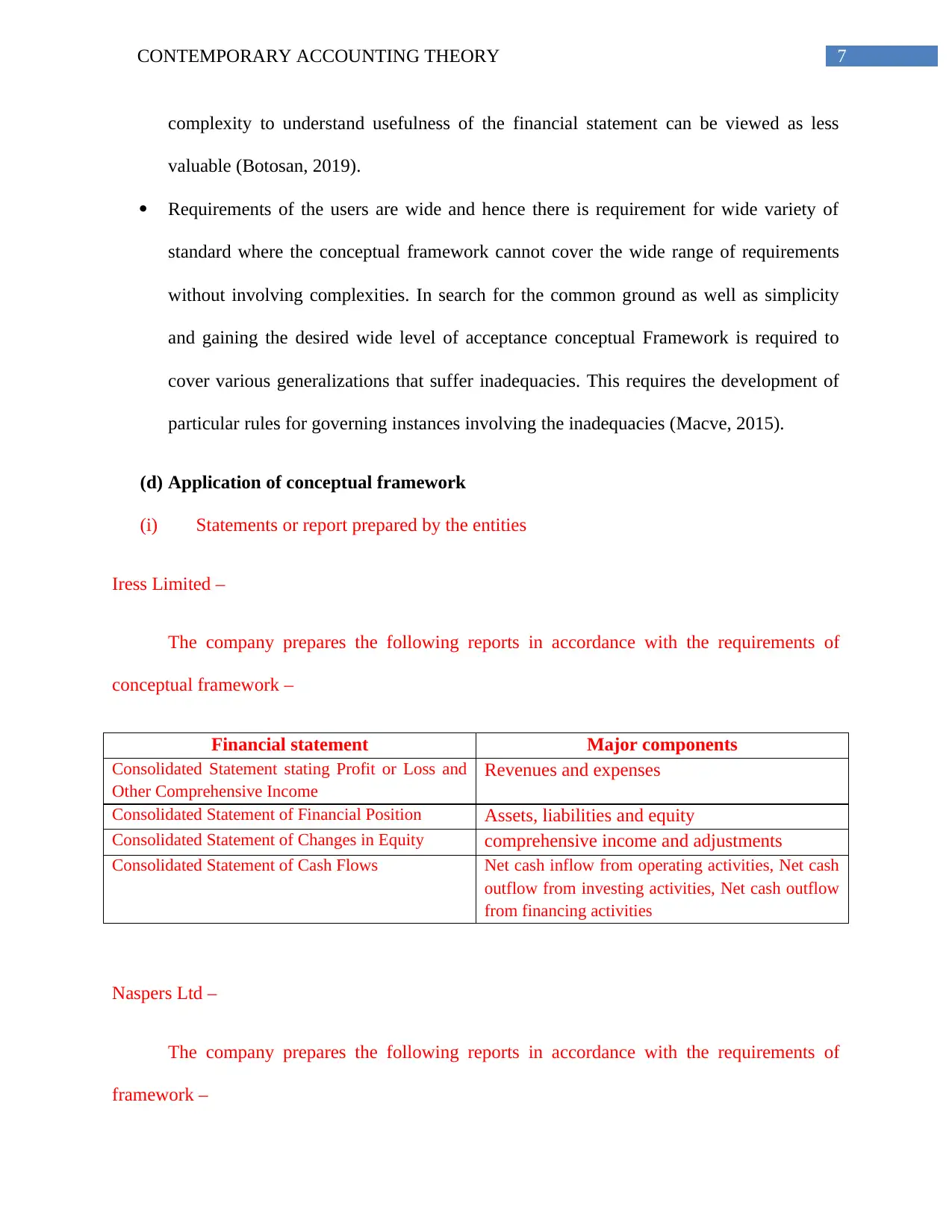
7CONTEMPORARY ACCOUNTING THEORY
complexity to understand usefulness of the financial statement can be viewed as less
valuable (Botosan, 2019).
Requirements of the users are wide and hence there is requirement for wide variety of
standard where the conceptual framework cannot cover the wide range of requirements
without involving complexities. In search for the common ground as well as simplicity
and gaining the desired wide level of acceptance conceptual Framework is required to
cover various generalizations that suffer inadequacies. This requires the development of
particular rules for governing instances involving the inadequacies (Macve, 2015).
(d) Application of conceptual framework
(i) Statements or report prepared by the entities
Iress Limited –
The company prepares the following reports in accordance with the requirements of
conceptual framework –
Financial statement Major components
Consolidated Statement stating Profit or Loss and
Other Comprehensive Income
Revenues and expenses
Consolidated Statement of Financial Position Assets, liabilities and equity
Consolidated Statement of Changes in Equity comprehensive income and adjustments
Consolidated Statement of Cash Flows Net cash inflow from operating activities, Net cash
outflow from investing activities, Net cash outflow
from financing activities
Naspers Ltd –
The company prepares the following reports in accordance with the requirements of
framework –
complexity to understand usefulness of the financial statement can be viewed as less
valuable (Botosan, 2019).
Requirements of the users are wide and hence there is requirement for wide variety of
standard where the conceptual framework cannot cover the wide range of requirements
without involving complexities. In search for the common ground as well as simplicity
and gaining the desired wide level of acceptance conceptual Framework is required to
cover various generalizations that suffer inadequacies. This requires the development of
particular rules for governing instances involving the inadequacies (Macve, 2015).
(d) Application of conceptual framework
(i) Statements or report prepared by the entities
Iress Limited –
The company prepares the following reports in accordance with the requirements of
conceptual framework –
Financial statement Major components
Consolidated Statement stating Profit or Loss and
Other Comprehensive Income
Revenues and expenses
Consolidated Statement of Financial Position Assets, liabilities and equity
Consolidated Statement of Changes in Equity comprehensive income and adjustments
Consolidated Statement of Cash Flows Net cash inflow from operating activities, Net cash
outflow from investing activities, Net cash outflow
from financing activities
Naspers Ltd –
The company prepares the following reports in accordance with the requirements of
framework –
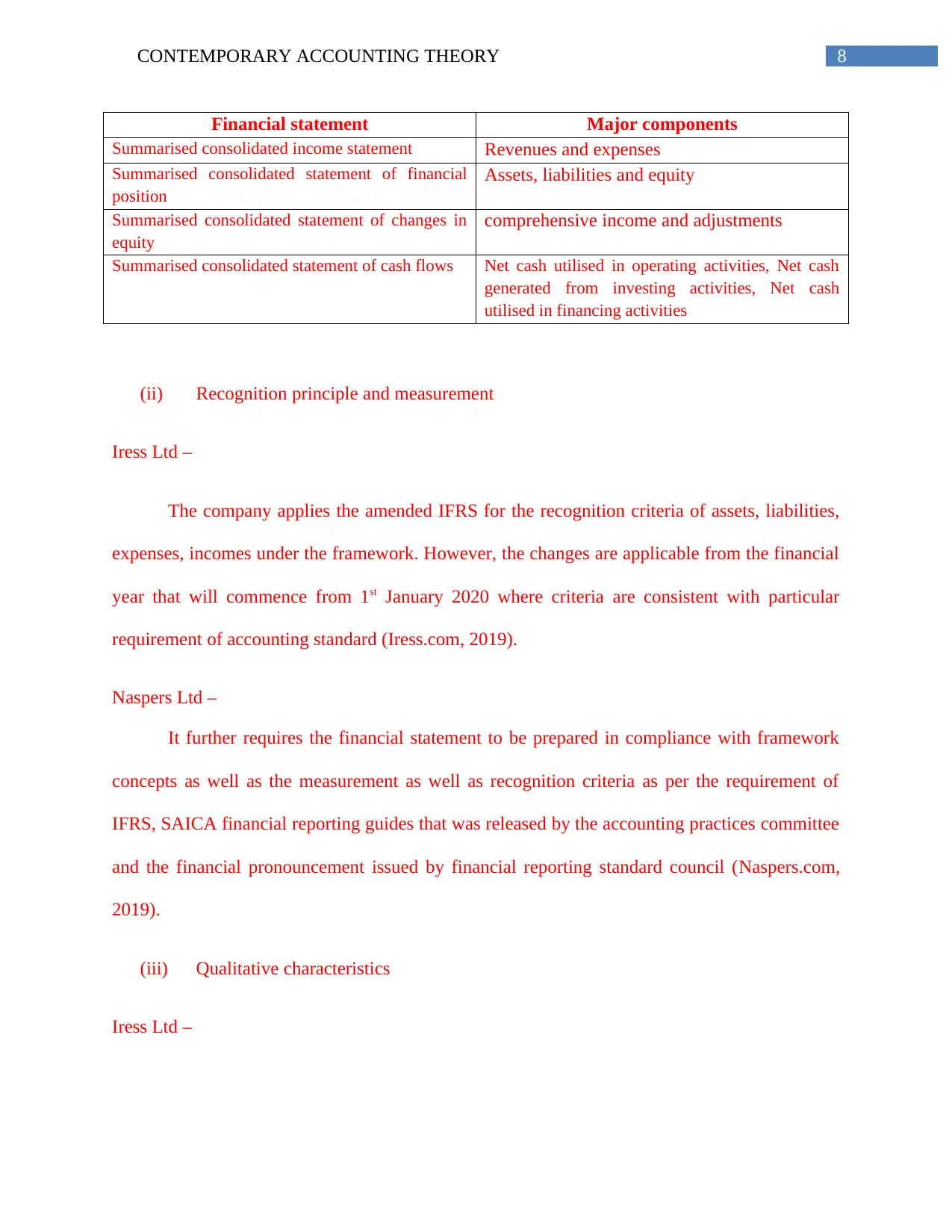
8CONTEMPORARY ACCOUNTING THEORY
Financial statement Major components
Summarised consolidated income statement Revenues and expenses
Summarised consolidated statement of financial
position
Assets, liabilities and equity
Summarised consolidated statement of changes in
equity
comprehensive income and adjustments
Summarised consolidated statement of cash flows Net cash utilised in operating activities, Net cash
generated from investing activities, Net cash
utilised in financing activities
(ii) Recognition principle and measurement
Iress Ltd –
The company applies the amended IFRS for the recognition criteria of assets, liabilities,
expenses, incomes under the framework. However, the changes are applicable from the financial
year that will commence from 1st January 2020 where criteria are consistent with particular
requirement of accounting standard (Iress.com, 2019).
Naspers Ltd –
It further requires the financial statement to be prepared in compliance with framework
concepts as well as the measurement as well as recognition criteria as per the requirement of
IFRS, SAICA financial reporting guides that was released by the accounting practices committee
and the financial pronouncement issued by financial reporting standard council (Naspers.com,
2019).
(iii) Qualitative characteristics
Iress Ltd –
Financial statement Major components
Summarised consolidated income statement Revenues and expenses
Summarised consolidated statement of financial
position
Assets, liabilities and equity
Summarised consolidated statement of changes in
equity
comprehensive income and adjustments
Summarised consolidated statement of cash flows Net cash utilised in operating activities, Net cash
generated from investing activities, Net cash
utilised in financing activities
(ii) Recognition principle and measurement
Iress Ltd –
The company applies the amended IFRS for the recognition criteria of assets, liabilities,
expenses, incomes under the framework. However, the changes are applicable from the financial
year that will commence from 1st January 2020 where criteria are consistent with particular
requirement of accounting standard (Iress.com, 2019).
Naspers Ltd –
It further requires the financial statement to be prepared in compliance with framework
concepts as well as the measurement as well as recognition criteria as per the requirement of
IFRS, SAICA financial reporting guides that was released by the accounting practices committee
and the financial pronouncement issued by financial reporting standard council (Naspers.com,
2019).
(iii) Qualitative characteristics
Iress Ltd –
⊘ This is a preview!⊘
Do you want full access?
Subscribe today to unlock all pages.

Trusted by 1+ million students worldwide
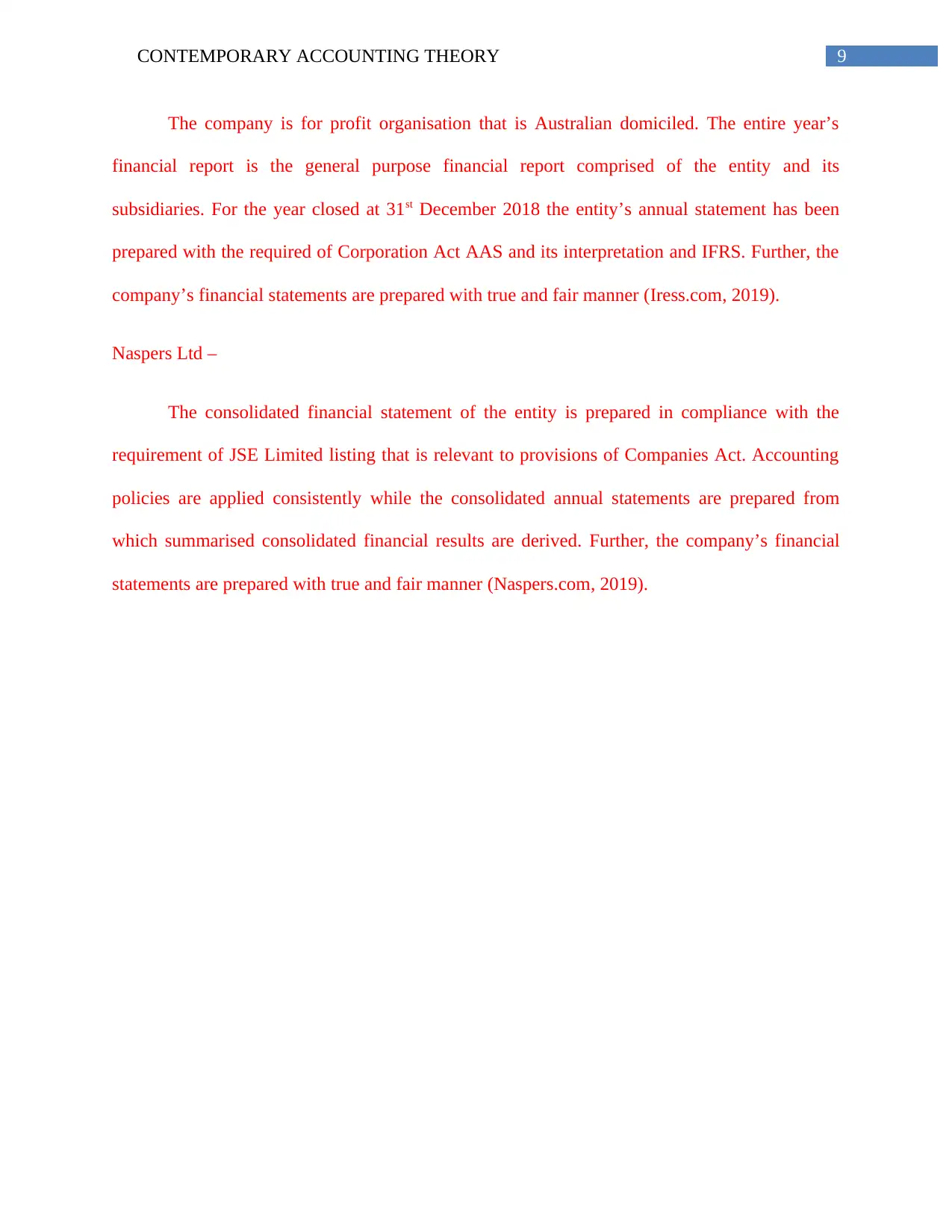
9CONTEMPORARY ACCOUNTING THEORY
The company is for profit organisation that is Australian domiciled. The entire year’s
financial report is the general purpose financial report comprised of the entity and its
subsidiaries. For the year closed at 31st December 2018 the entity’s annual statement has been
prepared with the required of Corporation Act AAS and its interpretation and IFRS. Further, the
company’s financial statements are prepared with true and fair manner (Iress.com, 2019).
Naspers Ltd –
The consolidated financial statement of the entity is prepared in compliance with the
requirement of JSE Limited listing that is relevant to provisions of Companies Act. Accounting
policies are applied consistently while the consolidated annual statements are prepared from
which summarised consolidated financial results are derived. Further, the company’s financial
statements are prepared with true and fair manner (Naspers.com, 2019).
The company is for profit organisation that is Australian domiciled. The entire year’s
financial report is the general purpose financial report comprised of the entity and its
subsidiaries. For the year closed at 31st December 2018 the entity’s annual statement has been
prepared with the required of Corporation Act AAS and its interpretation and IFRS. Further, the
company’s financial statements are prepared with true and fair manner (Iress.com, 2019).
Naspers Ltd –
The consolidated financial statement of the entity is prepared in compliance with the
requirement of JSE Limited listing that is relevant to provisions of Companies Act. Accounting
policies are applied consistently while the consolidated annual statements are prepared from
which summarised consolidated financial results are derived. Further, the company’s financial
statements are prepared with true and fair manner (Naspers.com, 2019).
Paraphrase This Document
Need a fresh take? Get an instant paraphrase of this document with our AI Paraphraser
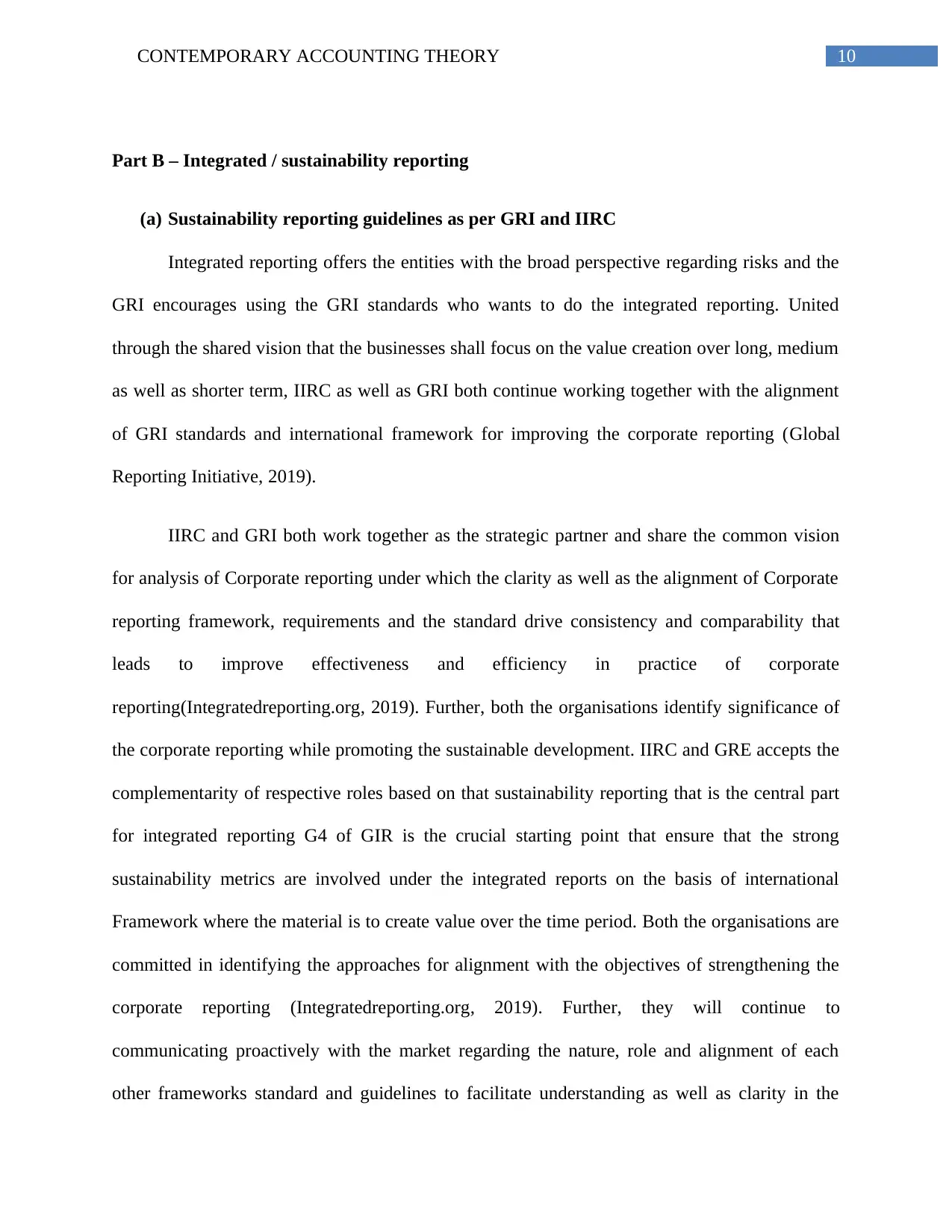
10CONTEMPORARY ACCOUNTING THEORY
Part B – Integrated / sustainability reporting
(a) Sustainability reporting guidelines as per GRI and IIRC
Integrated reporting offers the entities with the broad perspective regarding risks and the
GRI encourages using the GRI standards who wants to do the integrated reporting. United
through the shared vision that the businesses shall focus on the value creation over long, medium
as well as shorter term, IIRC as well as GRI both continue working together with the alignment
of GRI standards and international framework for improving the corporate reporting (Global
Reporting Initiative, 2019).
IIRC and GRI both work together as the strategic partner and share the common vision
for analysis of Corporate reporting under which the clarity as well as the alignment of Corporate
reporting framework, requirements and the standard drive consistency and comparability that
leads to improve effectiveness and efficiency in practice of corporate
reporting(Integratedreporting.org, 2019). Further, both the organisations identify significance of
the corporate reporting while promoting the sustainable development. IIRC and GRE accepts the
complementarity of respective roles based on that sustainability reporting that is the central part
for integrated reporting G4 of GIR is the crucial starting point that ensure that the strong
sustainability metrics are involved under the integrated reports on the basis of international
Framework where the material is to create value over the time period. Both the organisations are
committed in identifying the approaches for alignment with the objectives of strengthening the
corporate reporting (Integratedreporting.org, 2019). Further, they will continue to
communicating proactively with the market regarding the nature, role and alignment of each
other frameworks standard and guidelines to facilitate understanding as well as clarity in the
Part B – Integrated / sustainability reporting
(a) Sustainability reporting guidelines as per GRI and IIRC
Integrated reporting offers the entities with the broad perspective regarding risks and the
GRI encourages using the GRI standards who wants to do the integrated reporting. United
through the shared vision that the businesses shall focus on the value creation over long, medium
as well as shorter term, IIRC as well as GRI both continue working together with the alignment
of GRI standards and international framework for improving the corporate reporting (Global
Reporting Initiative, 2019).
IIRC and GRI both work together as the strategic partner and share the common vision
for analysis of Corporate reporting under which the clarity as well as the alignment of Corporate
reporting framework, requirements and the standard drive consistency and comparability that
leads to improve effectiveness and efficiency in practice of corporate
reporting(Integratedreporting.org, 2019). Further, both the organisations identify significance of
the corporate reporting while promoting the sustainable development. IIRC and GRE accepts the
complementarity of respective roles based on that sustainability reporting that is the central part
for integrated reporting G4 of GIR is the crucial starting point that ensure that the strong
sustainability metrics are involved under the integrated reports on the basis of international
Framework where the material is to create value over the time period. Both the organisations are
committed in identifying the approaches for alignment with the objectives of strengthening the
corporate reporting (Integratedreporting.org, 2019). Further, they will continue to
communicating proactively with the market regarding the nature, role and alignment of each
other frameworks standard and guidelines to facilitate understanding as well as clarity in the
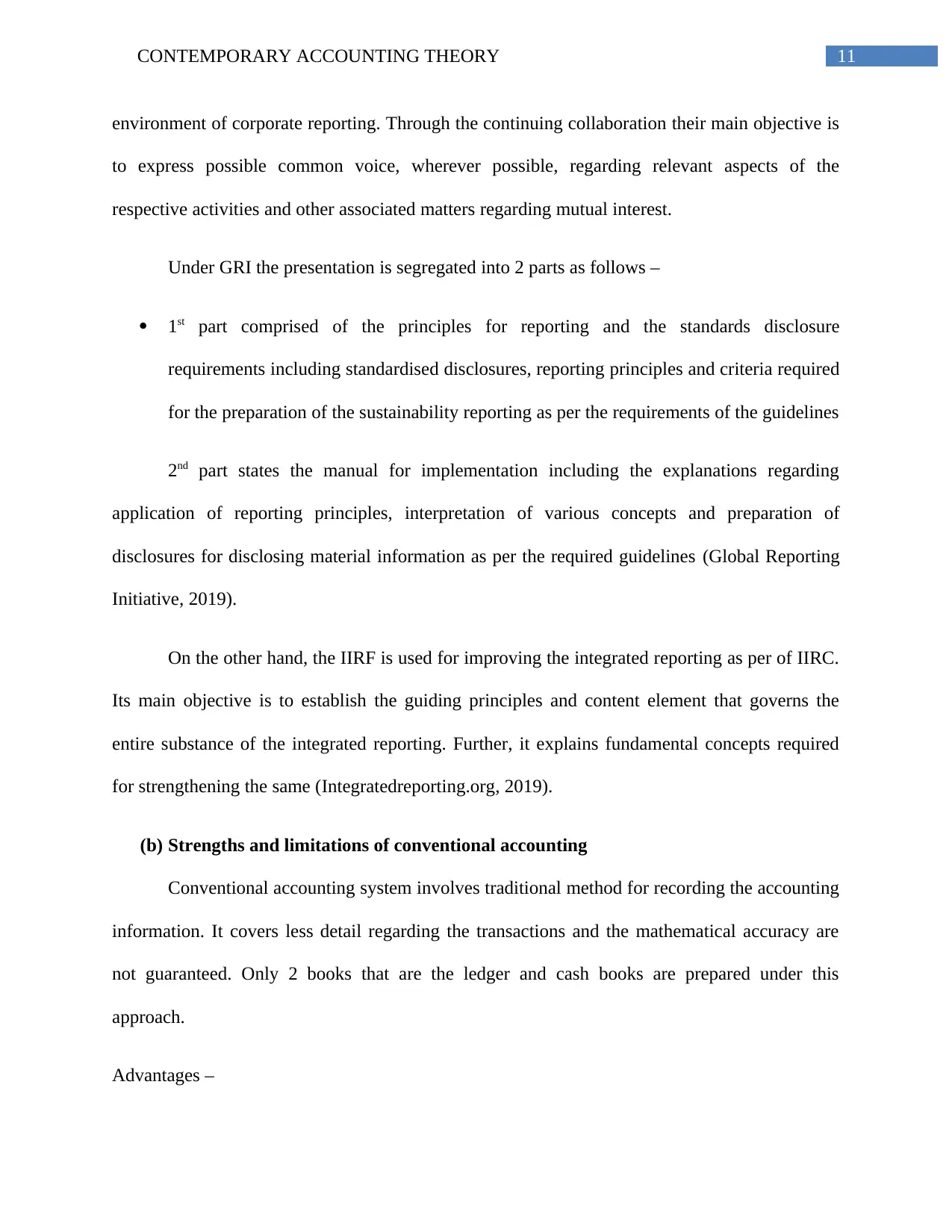
11CONTEMPORARY ACCOUNTING THEORY
environment of corporate reporting. Through the continuing collaboration their main objective is
to express possible common voice, wherever possible, regarding relevant aspects of the
respective activities and other associated matters regarding mutual interest.
Under GRI the presentation is segregated into 2 parts as follows –
1st part comprised of the principles for reporting and the standards disclosure
requirements including standardised disclosures, reporting principles and criteria required
for the preparation of the sustainability reporting as per the requirements of the guidelines
2nd part states the manual for implementation including the explanations regarding
application of reporting principles, interpretation of various concepts and preparation of
disclosures for disclosing material information as per the required guidelines (Global Reporting
Initiative, 2019).
On the other hand, the IIRF is used for improving the integrated reporting as per of IIRC.
Its main objective is to establish the guiding principles and content element that governs the
entire substance of the integrated reporting. Further, it explains fundamental concepts required
for strengthening the same (Integratedreporting.org, 2019).
(b) Strengths and limitations of conventional accounting
Conventional accounting system involves traditional method for recording the accounting
information. It covers less detail regarding the transactions and the mathematical accuracy are
not guaranteed. Only 2 books that are the ledger and cash books are prepared under this
approach.
Advantages –
environment of corporate reporting. Through the continuing collaboration their main objective is
to express possible common voice, wherever possible, regarding relevant aspects of the
respective activities and other associated matters regarding mutual interest.
Under GRI the presentation is segregated into 2 parts as follows –
1st part comprised of the principles for reporting and the standards disclosure
requirements including standardised disclosures, reporting principles and criteria required
for the preparation of the sustainability reporting as per the requirements of the guidelines
2nd part states the manual for implementation including the explanations regarding
application of reporting principles, interpretation of various concepts and preparation of
disclosures for disclosing material information as per the required guidelines (Global Reporting
Initiative, 2019).
On the other hand, the IIRF is used for improving the integrated reporting as per of IIRC.
Its main objective is to establish the guiding principles and content element that governs the
entire substance of the integrated reporting. Further, it explains fundamental concepts required
for strengthening the same (Integratedreporting.org, 2019).
(b) Strengths and limitations of conventional accounting
Conventional accounting system involves traditional method for recording the accounting
information. It covers less detail regarding the transactions and the mathematical accuracy are
not guaranteed. Only 2 books that are the ledger and cash books are prepared under this
approach.
Advantages –
⊘ This is a preview!⊘
Do you want full access?
Subscribe today to unlock all pages.

Trusted by 1+ million students worldwide
1 out of 20
Related Documents
Your All-in-One AI-Powered Toolkit for Academic Success.
+13062052269
info@desklib.com
Available 24*7 on WhatsApp / Email
![[object Object]](/_next/static/media/star-bottom.7253800d.svg)
Unlock your academic potential
Copyright © 2020–2025 A2Z Services. All Rights Reserved. Developed and managed by ZUCOL.





